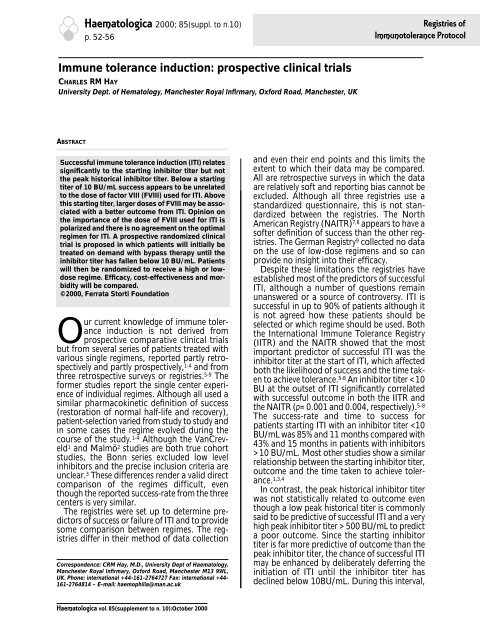Haematologica 2000;85:supplement to no. 10 - Supplements ...
Haematologica 2000;85:supplement to no. 10 - Supplements ...
Haematologica 2000;85:supplement to no. 10 - Supplements ...
Create successful ePaper yourself
Turn your PDF publications into a flip-book with our unique Google optimized e-Paper software.
<strong>Haema<strong>to</strong>logica</strong> <strong>2000</strong>; <strong>85</strong>(suppl. <strong>to</strong> n.<strong>10</strong>)<br />
p. 52-56<br />
Registries of<br />
Immu<strong>no</strong><strong>to</strong>lerance Pro<strong>to</strong>col<br />
Immune <strong>to</strong>lerance induction: prospective clinical trials<br />
CHARLES RM HAY<br />
University Dept. of Hema<strong>to</strong>logy, Manchester Royal Infirmary, Oxford Road, Manchester, UK<br />
ABSTRACT<br />
Successful immune <strong>to</strong>lerance induction (ITI) relates<br />
significantly <strong>to</strong> the starting inhibi<strong>to</strong>r titer but <strong>no</strong>t<br />
the peak his<strong>to</strong>rical inhibi<strong>to</strong>r titer. Below a starting<br />
titer of <strong>10</strong> BU/mL success appears <strong>to</strong> be unrelated<br />
<strong>to</strong> the dose of fac<strong>to</strong>r VIII (FVIII) used for ITI. Above<br />
this starting titer, larger doses of FVIII may be associated<br />
with a better outcome from ITI. Opinion on<br />
the importance of the dose of FVIII used for ITI is<br />
polarized and there is <strong>no</strong> agreement on the optimal<br />
regimen for ITI. A prospective randomized clinical<br />
trial is proposed in which patients will initially be<br />
treated on demand with bypass therapy until the<br />
inhibi<strong>to</strong>r titer has fallen below <strong>10</strong> BU/mL. Patients<br />
will then be randomized <strong>to</strong> receive a high or lowdose<br />
regime. Efficacy, cost-effectiveness and morbidity<br />
will be compared.<br />
©<strong>2000</strong>, Ferrata S<strong>to</strong>rti Foundation<br />
Our current k<strong>no</strong>wledge of immune <strong>to</strong>lerance<br />
induction is <strong>no</strong>t derived from<br />
prospective comparative clinical trials<br />
but from several series of patients treated with<br />
various single regimens, reported partly retrospectively<br />
and partly prospectively, 1-4 and from<br />
three retrospective surveys or registries. 5-9 The<br />
former studies report the single center experience<br />
of individual regimes. Although all used a<br />
similar pharmacokinetic definition of success<br />
(res<strong>to</strong>ration of <strong>no</strong>rmal half-life and recovery),<br />
patient-selection varied from study <strong>to</strong> study and<br />
in some cases the regime evolved during the<br />
course of the study. 1-4 Although the VanCreveld<br />
1 and Malmö 2 studies are both true cohort<br />
studies, the Bonn series excluded low level<br />
inhibi<strong>to</strong>rs and the precise inclusion criteria are<br />
unclear. 3 These differences render a valid direct<br />
comparison of the regimes difficult, even<br />
though the reported success-rate from the three<br />
centers is very similar.<br />
The registries were set up <strong>to</strong> determine predic<strong>to</strong>rs<br />
of success or failure of ITI and <strong>to</strong> provide<br />
some comparison between regimes. The registries<br />
differ in their method of data collection<br />
Correspondence: CRM Hay, M.D., University Dept of Haema<strong>to</strong>logy,<br />
Manchester Royal Infirmary, Oxford Road, Manchester M13 9WL,<br />
UK. Phone: international +44-161-2764727 Fax: international +44-<br />
161-2764814 – E-mail: haemophilia@man.ac.uk<br />
and even their end points and this limits the<br />
extent <strong>to</strong> which their data may be compared.<br />
All are retrospective surveys in which the data<br />
are relatively soft and reporting bias can<strong>no</strong>t be<br />
excluded. Although all three registries use a<br />
standardized questionnaire, this is <strong>no</strong>t standardized<br />
between the registries. The North<br />
American Registry (NAITR) 7,8 appears <strong>to</strong> have a<br />
softer definition of success than the other registries.<br />
The German Registry 9 collected <strong>no</strong> data<br />
on the use of low-dose regimens and so can<br />
provide <strong>no</strong> insight in<strong>to</strong> their efficacy.<br />
Despite these limitations the registries have<br />
established most of the predic<strong>to</strong>rs of successful<br />
ITI, although a number of questions remain<br />
unanswered or a source of controversy. ITI is<br />
successful in up <strong>to</strong> 90% of patients although it<br />
is <strong>no</strong>t agreed how these patients should be<br />
selected or which regime should be used. Both<br />
the International Immune Tolerance Registry<br />
(IITR) and the NAITR showed that the most<br />
important predic<strong>to</strong>r of successful ITI was the<br />
inhibi<strong>to</strong>r titer at the start of ITI, which affected<br />
both the likelihood of success and the time taken<br />
<strong>to</strong> achieve <strong>to</strong>lerance. 5-8 An inhibi<strong>to</strong>r titer 500 BU/mL <strong>to</strong> predict<br />
a poor outcome. Since the starting inhibi<strong>to</strong>r<br />
titer is far more predictive of outcome than the<br />
peak inhibi<strong>to</strong>r titer, the chance of successful ITI<br />
may be enhanced by deliberately deferring the<br />
initiation of ITI until the inhibi<strong>to</strong>r titer has<br />
declined below <strong>10</strong>BU/mL. During this interval,<br />
<strong>Haema<strong>to</strong>logica</strong> vol. <strong>85</strong>(<strong>supplement</strong> <strong>to</strong> n. <strong>10</strong>):Oc<strong>to</strong>ber <strong>2000</strong>
















